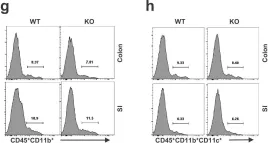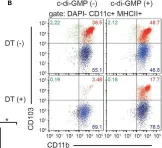Brucellosis poses a significant public health challenge, necessitating effective vaccine development. Current vaccines have limitations such as safety concerns and inadequate mucosal immunity. This study aims to develop an FcRn-targeted mucosal Brucella vaccine by fusing the human Fc domain with Brucella's multi-epitope protein (MEV), proposing a novel approach for human brucellosis prevention.
The study developed a recombinant antigen (h-tFc-MEV) through computational analyses to validate antigenicity, structural stability, solubility, and allergenic potential. Molecular simulations confirmed FcRn binding. The vaccine was delivered orally via chitosan nanoparticles in murine models. Immunization was compared to MEV-only immunization. Post-challenge assessments were conducted to evaluate protection against Brucella colonization. Mechanistic studies investigated dendritic cell activation and antigen presentation.
Computational analyses showed that the antigen had favorable properties without allergenic potential. Molecular simulations demonstrated robust FcRn binding. In murine models, oral delivery elicited enhanced systemic immunity with elevated serum IgG titers and amplified CD4+/CD8+ T-cell ratios compared to MEV-only immunization. Mucosal immunity was evidenced by significant IgA upregulation across multiple tracts. Long-term immune memory persisted for six months. Post-challenge assessments revealed markedly reduced Brucella colonization in visceral organs. Mechanistic studies identified FcRn-mediated dendritic cell activation through enhanced MHC-II expression and antigen presentation efficiency.
The FcRn-targeted strategy establishes concurrent mucosal and systemic protective immunity against Brucella infection. This novel vaccine candidate shows potential for effective human brucellosis prevention, offering a promising approach to address the limitations of current vaccines.
Product Citations: 133
In Vaccines on 26 May 2025 by Tian, T., Zhu, Y., et al.
-
Immunology and Microbiology
In Clinical and Molecular Hepatology on 1 April 2025 by Zeng, W., Liu, F., et al.
Transmembrane 4 L six family member 1 (TM4SF1) is highly expressed and contributes to the progression of various malignancies. However, how it modulates hepatocellular carcinoma (HCC) progression and senescence remains to be elucidated.
TM4SF1 expression in HCC samples was evaluated using immunohistochemistry and flow cytometry. Cellular senescence was assessed through SA-β-gal activity assays and Western blot analysis. TM4SF1-related protein interactions were investigated using immunoprecipitation-mass spectrometry, co-immunoprecipitation, bimolecular fluorescence complementation, and immunofluorescence. Tumor-infiltrating immune cells were analyzed by flow cytometry. The HCC mouse model was established via hydrodynamic tail vein injection.
TM4SF1 was highly expressed in human HCC samples and murine models. Knockdown of TM4SF1 suppressed HCC proliferation both in vitro and in vivo, inducing non-secretory senescence through upregulation of p16 and p21. TM4SF1 enhanced the interaction between AKT1 and PDPK1, thereby promoting AKT phosphorylation, which subsequently downregulated p16 and p21. Meanwhile, TM4SF1-mediated AKT phosphorylation enhanced PD-L1 expression while reducing major histocompatibility complex class I level on tumor cells, leading to impaired cytotoxic function of CD8+ T cells and an increased proportion of exhausted CD8+ T cells. In clinical HCC samples, elevated TM4SF1 expression was associated with resistance to anti-PD-1 immunotherapy. Targeting TM4SF1 via adeno-associated virus induced tumor senescence, reduced tumor burden and synergistically enhanced the efficacy of anti-PD-1 therapy.
Our results revealed that TM4SF1 regulated tumor cell senescence and immune evasion through the AKT pathway, highlighting its potential as a therapeutic target in HCC, particularly in combination with first-line immunotherapy.
-
Mus musculus (House mouse)
-
Cancer Research
-
Immunology and Microbiology
In STAR Protocols on 21 March 2025 by Ingelshed, K., Melssen, M. M., et al.
Here, we present a protocol for guiding tissue preparation and flow cytometric analysis in subcutaneous murine tumor models and secondary lymphoid organs. We describe steps for dissociating tumors, spleens, and lymph nodes to obtain single-cell suspensions. We then detail procedures for immune cell staining and analysis and gating strategies including the use of fluorescence-minus-one controls (FMOs). This approach provides valuable insights into the impact of cancer therapies on the tumor and systemic immune response. For complete details on the use and execution of this protocol, please refer to Ingelshed et al.1.
Copyright © 2024 The Author(s). Published by Elsevier Inc. All rights reserved.
-
Cancer Research
-
Immunology and Microbiology
In Immunity on 11 February 2025 by Robles-Vera, I., Jarit-Cabanillas, A., et al.
Impairment of the intestinal barrier allows the systemic translocation of commensal bacteria, inducing a proinflammatory state in the host. Here, we investigated innate immune responses following increased gut permeability upon administration of dextran sulfate sodium (DSS) in mice. We found that Enterococcus faecalis translocated to the bone marrow following DSS treatment and induced trained immunity (TI) hallmarks in bone-marrow-derived mouse macrophages and human monocytes. DSS treatment or heat-killed E. faecalis reprogrammed bone marrow progenitors (BMPs), resulting in enhanced inflammatory responses in vitro and in vivo and protection against subsequent pathogen infections. The C-type lectin receptor Mincle (Clec4e) was essential for E. faecalis-induced TI in BMPs. Clec4e-/- mice showed impaired TI upon E. faecalis administration and reduced pathology following DSS treatment. Thus, Mincle sensing of E. faecalis induces TI that may have long-term effects on pathologies associated with increased gut permeability.
Copyright © 2025 The Authors. Published by Elsevier Inc. All rights reserved.
-
Immunology and Microbiology
In PLoS Pathogens on 1 February 2025 by Bercusson, A., Williams, T. J., et al.
Aspergillus fumigatus (Af) is a major mould pathogen found ubiquitously in the air. It commonly infects the airways of people with cystic fibrosis (CF) leading to Aspergillus bronchitis or allergic bronchopulmonary aspergillosis. Resident alveolar macrophages and recruited neutrophils are important first lines of defence for clearance of Af in the lung. However, their contribution to the inflammatory phenotype in CF during Af infection is not well understood. Here, utilising CFTR deficient mice we describe a hyperinflammatory phenotype in both acute and allergic murine models of pulmonary aspergillosis. We show that during aspergillosis, CFTR deficiency leads to increased alveolar macrophage death and persistent inflammation of the airways in CF, accompanied by impaired fungal control. Utilising CFTR deficient murine cells and primary human CF cells we show that at a cellular level there is increased activation of NFκB and NFAT in response to Af which, as in in vivo models, is associated with increased cell death and reduced fungal control. Taken together, these studies indicate that CFTR deficiency promotes increased activation of inflammatory pathways, the induction of macrophage cell death and reduced fungal control contributing to the hyper-inflammatory of pulmonary aspergillosis phenotypes in CF.
Copyright: © 2025 Bercusson et al. This is an open access article distributed under the terms of the Creative Commons Attribution License, which permits unrestricted use, distribution, and reproduction in any medium, provided the original author and source are credited.
-
Immunology and Microbiology
In Elife on 30 October 2019 by Sifuentes-Dominguez, L., Li, H., et al.
Fig.5.G

-
FC/FACS
-
Homo sapiens (Human)
Collected and cropped from Elife by CiteAb, provided under a CC-BY license
Image 1 of 2
In Front Immunol on 6 June 2018 by Liu, S., Xia, Q., et al.
Fig.3.B

-
FC/FACS
-
Mus musculus (House mouse)
Collected and cropped from Front Immunol by CiteAb, provided under a CC-BY license
Image 1 of 2

